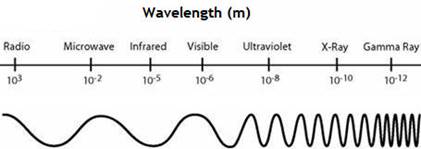
World of Chemistry
7th Edition
ISBN: 9780618562763
Author: Steven S. Zumdahl
Publisher: Houghton Mifflin College Div
expand_more
expand_more
format_list_bulleted
Concept explainers
Question
Chapter 11, Problem 1STP
Interpretation Introduction
Interpretation: The form of
Concept introduction: Electromagnetic radiation is produced by oscillating electric and magnetic field line in the vacuum.
Expert Solution & Answer
Answer to Problem 1STP
- Microwaves
Explanation of Solution

As it can be seen from the electromagnetic radiation, Radio waves have the maximum wavelength and gamma ray have maximum energy.
Therefore, 
Conclusion
Radiation provides an important means of energy transfer.
Chapter 11 Solutions
World of Chemistry
Ch. 11.1 - Prob. 1RQCh. 11.1 - Prob. 2RQCh. 11.1 - Prob. 3RQCh. 11.1 - Prob. 4RQCh. 11.1 - Prob. 5RQCh. 11.1 - Prob. 6RQCh. 11.2 - Prob. 1RQCh. 11.2 - Prob. 2RQCh. 11.2 - Prob. 3RQCh. 11.2 - Prob. 4RQ
Ch. 11.2 - Prob. 5RQCh. 11.2 - Prob. 6RQCh. 11.3 - Prob. 1RQCh. 11.3 - Prob. 2RQCh. 11.3 - Prob. 3RQCh. 11.3 - Prob. 4RQCh. 11.3 - Prob. 5RQCh. 11.3 - Prob. 6RQCh. 11.4 - Prob. 1RQCh. 11.4 - Prob. 2RQCh. 11.4 - Prob. 3RQCh. 11.4 - Prob. 4RQCh. 11.4 - Prob. 5RQCh. 11.4 - Prob. 6RQCh. 11.4 - Prob. 7RQCh. 11 - Prob. 1ACh. 11 - Prob. 2ACh. 11 - Prob. 3ACh. 11 - Prob. 4ACh. 11 - Prob. 5ACh. 11 - Prob. 6ACh. 11 - Prob. 7ACh. 11 - Prob. 8ACh. 11 - Prob. 9ACh. 11 - Prob. 10ACh. 11 - Prob. 11ACh. 11 - Prob. 12ACh. 11 - Prob. 13ACh. 11 - Prob. 14ACh. 11 - Prob. 15ACh. 11 - Prob. 16ACh. 11 - Prob. 17ACh. 11 - Prob. 18ACh. 11 - Prob. 19ACh. 11 - Prob. 20ACh. 11 - Prob. 21ACh. 11 - Prob. 22ACh. 11 - Prob. 23ACh. 11 - Prob. 24ACh. 11 - Prob. 25ACh. 11 - Prob. 26ACh. 11 - Prob. 27ACh. 11 - Prob. 28ACh. 11 - Prob. 29ACh. 11 - Prob. 30ACh. 11 - Prob. 31ACh. 11 - Prob. 32ACh. 11 - Prob. 33ACh. 11 - Prob. 34ACh. 11 - Prob. 35ACh. 11 - Prob. 36ACh. 11 - Prob. 37ACh. 11 - Prob. 38ACh. 11 - Prob. 39ACh. 11 - Prob. 40ACh. 11 - Prob. 41ACh. 11 - Prob. 42ACh. 11 - Prob. 43ACh. 11 - Prob. 44ACh. 11 - Prob. 45ACh. 11 - Prob. 46ACh. 11 - Prob. 47ACh. 11 - Prob. 48ACh. 11 - Prob. 49ACh. 11 - Prob. 50ACh. 11 - Prob. 51ACh. 11 - Prob. 52ACh. 11 - Prob. 53ACh. 11 - Prob. 54ACh. 11 - Prob. 55ACh. 11 - Prob. 56ACh. 11 - Prob. 57ACh. 11 - Prob. 58ACh. 11 - Prob. 59ACh. 11 - Prob. 60ACh. 11 - Prob. 61ACh. 11 - Prob. 62ACh. 11 - Prob. 63ACh. 11 - Prob. 64ACh. 11 - Prob. 65ACh. 11 - Prob. 66ACh. 11 - Prob. 67ACh. 11 - Prob. 68ACh. 11 - Prob. 69ACh. 11 - Prob. 70ACh. 11 - Prob. 71ACh. 11 - Prob. 72ACh. 11 - Prob. 73ACh. 11 - Prob. 74ACh. 11 - Prob. 1STPCh. 11 - Prob. 2STPCh. 11 - Prob. 3STPCh. 11 - Prob. 4STPCh. 11 - Prob. 5STPCh. 11 - Prob. 6STPCh. 11 - Prob. 7STPCh. 11 - Prob. 8STPCh. 11 - Prob. 9STPCh. 11 - Prob. 10STPCh. 11 - Prob. 11STPCh. 11 - Prob. 12STP
Knowledge Booster
Learn more about
Need a deep-dive on the concept behind this application? Look no further. Learn more about this topic, chemistry and related others by exploring similar questions and additional content below.Similar questions
- If 10 mL of a commercial sodium silicate solution is added, the water required to obtain a 20% solids solution (SiO2+Na2O) is added. Indicate the final grams of Na2SiO3.arrow_forwardPlease help me figure out the mechanism with arrows of the following reactionarrow_forwardOrganic Functional Groups Predicting the reactants or products of acetal hydrolysis termine the structures of the missing organic molecules in the following reaction: H* H* + H₂O Y ☑ Note: Molecules that share the same letter have the exact same structure. In the drawing area below, draw the skeletal ("line") structures of the missing organic molecules X, Y, and Z. You may draw that you like, so long as they aren't touching. Molecule X shows up in multiple steps, but you only have to draw its structure Explanation Check @2 W Click and drag to start drawing a structure. #4 # 3 LU E % 67 olo 5 66 R T Y & 7 AcGraw Hill LLC. All Rights R Xarrow_forward
arrow_back_ios
SEE MORE QUESTIONS
arrow_forward_ios
Recommended textbooks for you
 ChemistryChemistryISBN:9781305957404Author:Steven S. Zumdahl, Susan A. Zumdahl, Donald J. DeCostePublisher:Cengage Learning
ChemistryChemistryISBN:9781305957404Author:Steven S. Zumdahl, Susan A. Zumdahl, Donald J. DeCostePublisher:Cengage Learning ChemistryChemistryISBN:9781259911156Author:Raymond Chang Dr., Jason Overby ProfessorPublisher:McGraw-Hill Education
ChemistryChemistryISBN:9781259911156Author:Raymond Chang Dr., Jason Overby ProfessorPublisher:McGraw-Hill Education Principles of Instrumental AnalysisChemistryISBN:9781305577213Author:Douglas A. Skoog, F. James Holler, Stanley R. CrouchPublisher:Cengage Learning
Principles of Instrumental AnalysisChemistryISBN:9781305577213Author:Douglas A. Skoog, F. James Holler, Stanley R. CrouchPublisher:Cengage Learning Organic ChemistryChemistryISBN:9780078021558Author:Janice Gorzynski Smith Dr.Publisher:McGraw-Hill Education
Organic ChemistryChemistryISBN:9780078021558Author:Janice Gorzynski Smith Dr.Publisher:McGraw-Hill Education Chemistry: Principles and ReactionsChemistryISBN:9781305079373Author:William L. Masterton, Cecile N. HurleyPublisher:Cengage Learning
Chemistry: Principles and ReactionsChemistryISBN:9781305079373Author:William L. Masterton, Cecile N. HurleyPublisher:Cengage Learning Elementary Principles of Chemical Processes, Bind...ChemistryISBN:9781118431221Author:Richard M. Felder, Ronald W. Rousseau, Lisa G. BullardPublisher:WILEY
Elementary Principles of Chemical Processes, Bind...ChemistryISBN:9781118431221Author:Richard M. Felder, Ronald W. Rousseau, Lisa G. BullardPublisher:WILEY

Chemistry
Chemistry
ISBN:9781305957404
Author:Steven S. Zumdahl, Susan A. Zumdahl, Donald J. DeCoste
Publisher:Cengage Learning

Chemistry
Chemistry
ISBN:9781259911156
Author:Raymond Chang Dr., Jason Overby Professor
Publisher:McGraw-Hill Education

Principles of Instrumental Analysis
Chemistry
ISBN:9781305577213
Author:Douglas A. Skoog, F. James Holler, Stanley R. Crouch
Publisher:Cengage Learning

Organic Chemistry
Chemistry
ISBN:9780078021558
Author:Janice Gorzynski Smith Dr.
Publisher:McGraw-Hill Education

Chemistry: Principles and Reactions
Chemistry
ISBN:9781305079373
Author:William L. Masterton, Cecile N. Hurley
Publisher:Cengage Learning

Elementary Principles of Chemical Processes, Bind...
Chemistry
ISBN:9781118431221
Author:Richard M. Felder, Ronald W. Rousseau, Lisa G. Bullard
Publisher:WILEY
Quantum Mechanics - Part 1: Crash Course Physics #43; Author: CrashCourse;https://www.youtube.com/watch?v=7kb1VT0J3DE;License: Standard YouTube License, CC-BY